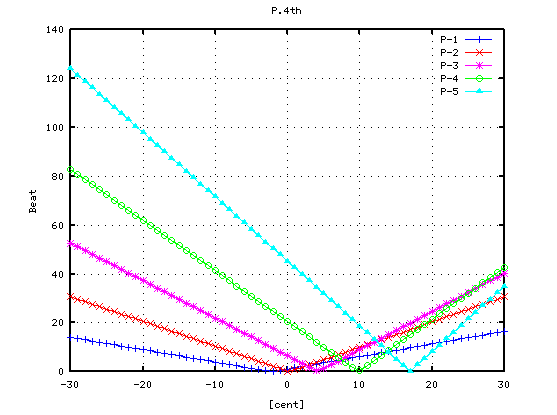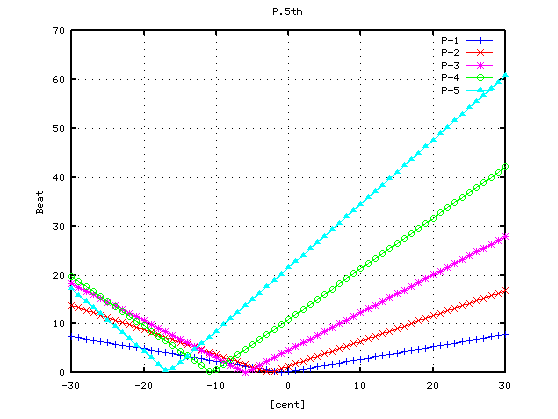インハーモニシティのある場合です。
2キー間で 片方のキーを変化させた時の
倍音の“うなり”の変化を見てみます。
function dispIKbeats(key, inte)
global Inha Cent KB;
KB = 88;
grade = 0.087;
Inha = makeCurve(28, 0.55, grade);
Cent = tuning_c(Inha, 1.0, grade);
multiple = 1:5; # 倍音の範囲
widec = 30; # ±セント値の範囲
[ratio rstr]= Interval(inte);
for m = multiple
ra = [ratio(2:3)*m inte];
be = abs(getIKbeat(key, ra, -widec:widec));
str = strcat(';P-', num2str(m), ';-@', getCP(m));
plot(-widec:widec, be, str)
hold on
end
hold off
title(rstr)
xlabel('[cent]')
ylabel('Beat')
grid on
end
function beat = getIKbeat(key, ratio, cent) freq1 = getIFrequ(key, ratio(1)); freq2 = getIFrequ(key+ratio(3), ratio(2)); freq2 = ctof(freq2, cent); beat = freq2-freq1; end
function [inter, intst] = Interval(inte) # v0.2
intn = [0 1 1; 1 16 15; 2 9 8; 3 6 5; 4 5 4; 5 4 3; 6 7 5;\
7 3 2; 8 8 5; 9 5 3; 10 7 4; 11 15 8; 12 2 1;\
16 5 2; 19 3 1; 24 4 1; 28 5 1; 31 6 1; 36 8 1];
ratio = {'Unison' 'mi.2nd' 'Mj.2nd' 'mi.3rd' 'Mj.3rd' 'P.4th' 'Dim.5th'\
'P.5th' 'mi.6th' 'Mj.6th' 'mi.7th' 'Mj.7th' 'Octave'\
'10th' '12th' '2octave' 'Oct.10th' 'Oct.12th' '3octave'};
inter = -1; # not
intst = '';
x = find(intn(:, 1) == abs(inte));
if (x > 0)
if (inte > 0)
inter = intn(x, 1:3);
else
inter = [intn(x,1) intn(x,3) intn(x,2)];
end
intst = ratio{x};
else
usage("Interval([0-36]) -> [interval low high][name]");
end
end
dispKbeats1.m と getKbeat.mの一部を改造して dispIKbeats.m と getIKbeat.mとして 他はそのまま使います。
Interval.m は キー間隔のマイナスに対応させました。
Tuningのシミュレーションを行ってから 2キー間の倍音の“うなり”の変化を見てみます。
> dispIKbeats(37, 5)

37Aキーの 4度上です。
> dispIKbeats(37, -7)

37Aキーの 5度下です。
> dispIKbeats(37, 12)

37Aキーのオクターブ上です。